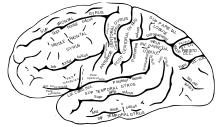Angular gyrus
The angular gyrus is a twist (from the Greek gyrus "winding" and Latin angularis "angular") of the cerebral cortex at the rear end of the superior temporal sulcus . It corresponds to the Brodmann area 39. This is where the parietal , temporal and occipital lobes meet.
Anatomical location
The angular gyrus is assigned to the parietal lobe. On the frontal side, it is bounded by the supramarginal gyrus (Brodmann area 40), the superior temporalis gyrus and the medius temporal gyrus , occipitally (rear) by the tertiary visual cortex (Brodmann area 19) and towards the vertex by the parietal lobule inferior .
Blood supply
The angular gyrus is supplied by the angular artery and a terminal branch of the posterior parietal artery, both branches of the middle cerebral artery . The (rare) isolated infarction of these blood vessels leads accordingly to the so-called angularis syndrome . Bleeding, tumors, inflammation, injuries and similar damage can also be the cause.
function
The angular gyrus is one of the higher association areas of the cerebral cortex. It plays a decisive role in the networking of higher visual and hearing centers with higher sensory and motor areas. He is thus decisively involved in functions such as writing, reading and arithmetic. But higher human cognitive performances such as the ability to abstract are also attributed to him. According to its function, damage to the angular gyrus usually manifests itself in a reading ( alexia ) and / or writing ( agraphia ) disorder . Furthermore, those affected are usually unable to relate things they see to a certain term and to name them with that.
See also
Individual evidence
- ↑ Federative Committee on Anatomical Terminology (1998). Terminologia Anatomica . Stuttgart: Thieme
- ^ A b Neuroanatomie, Martin Trepel, 1st edition (1995), Urban & Schwarzenberg, ISBN 3-541-13431-3
- ^ Duus' Neurological-topical Diagnostics, Mathias Bähr and Michael Frotscher, 8th edition (2003), p. 393, Georg Thieme Verlag, ISBN 3-13-535808-9
- ↑ "Purple Numbers and Sharp Cheese" in: "A short journey through mind and brain", Ramachandran V. (2005), pp. 73ff, Rowohlt Taschenbuch Verlag, ISBN 3-499-61987-3
- ^ "Neuroanatomie", Martin Trepel (2012), p. 245, Urban & Fischer Verlag, ISBN 978-3-437-41299-8
